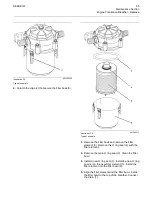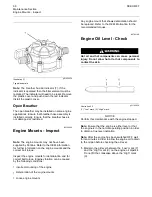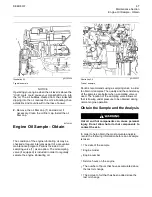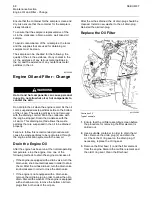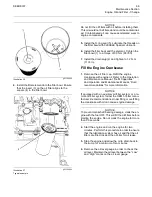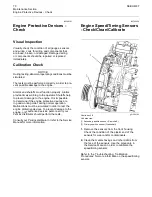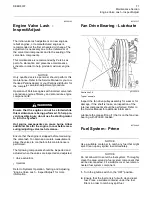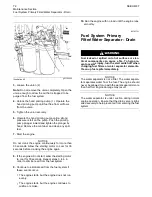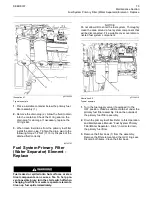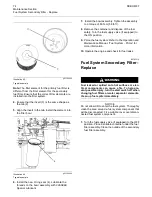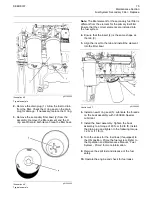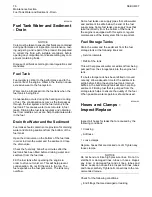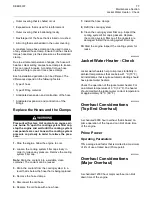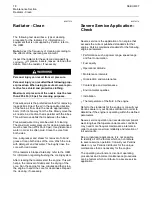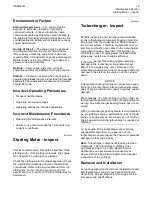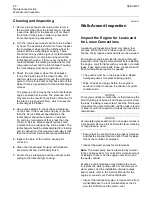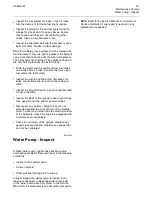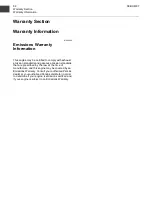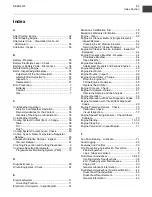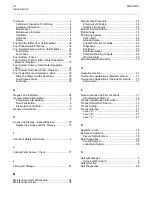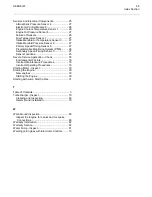
78
SEBU8337
Maintenance Section
Radiator - Clean
i02857274
Radiator - Clean
The following text describes a typical cleaning
procedure for the radiator. For information on
equipment that is not supplied by Perkins, refer to
the OEM.
Note:
Adjust the frequency of cleaning according to
the effects of the operating environment.
Inspect the radiator for these items: damaged
fi
ns,
corrosion, dirt, grease, insects, leaves, oil, and other
debris. Clean the radiator, if necessary.
Personal injury can result from air pressure.
Personal injury can result without following prop-
er procedure. When using pressure air, wear a pro-
tective face shield and protective clothing.
Maximum air pressure at the nozzle must be less
than 205 kPa (30 psi) for cleaning purposes.
Pressurized air is the preferred method for removing
loose debris. Direct the air in the opposite direction
of the fan’s air
fl
ow. Hold the nozzle approximately
6 mm (0.25 inch) away from the
fi
ns. Slowly move the
air nozzle in a direction that is parallel with the tubes.
This will remove debris that is between the tubes.
Pressurized water may also be used for cleaning.
The maximum water pressure for cleaning purposes
must be less than 275 kPa (40 psi). Use pressurized
water in order to soften mud. Clean the core from
both sides.
Use a degreaser and steam for removal of oil and
grease. Clean both sides of the core. Wash the core
with detergent and hot water. Thoroughly rinse the
core with clean water.
If the radiator is blocked internally, refer to the OEM
for information regarding
fl
ushing the cooling system.
After cleaning the radiator, start the engine. This will
help in the removal of debris and the drying of the
core. Run the engine for two minutes and then stop
the engine. Inspect the core for cleanliness. Repeat
the cleaning, if necessary.
i02578376
Severe Service Application -
Check
Severe service is the application of an engine that
exceeds the current published standards for that
engine. Perkins maintains standards for the following
engine parameters:
•
Performance such as power range, speed range,
and fuel consumption
•
Fuel quality
•
Operational Altitude
•
Maintenance intervals
•
Oil selection and maintenance
•
Coolant type and maintenance
•
Environmental qualities
•
Installation
•
The temperature of the
fl
uid in the engine
Refer to the standards for the engine or consult your
Perkins dealer or your Perkins distributor in order to
determine if the engine is operating within the de
fi
ned
parameters.
Severe service operation can accelerate component
wear. Engines that operate under severe conditions
may need more frequent maintenance intervals in
order to ensure maximum reliability and retention of
full service life.
Due to individual applications, it is not possible
to identify all of the factors which can contribute
to severe service operation. Consult your Perkins
dealer or your Perkins distributor for the unique
maintenance that is necessary for the engine.
The operating environment, incorrect operating
procedures and incorrect maintenance procedures
can be factors which contribute to a severe service
application.


